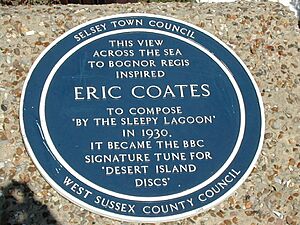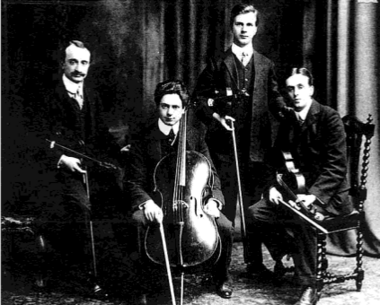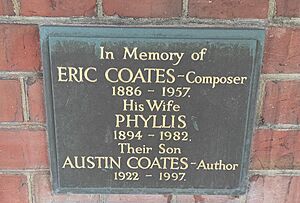Eric Coates facts for kids
Eric Francis Harrison Coates (born August 27, 1886 – died December 21, 1957) was a famous English composer. He was known for his "light music," which is often cheerful and easy to listen to. Early in his career, he was also a very talented viola player.
Coates grew up in a musical family. Even though he had a clear talent for music, his parents weren't sure about him becoming a professional musician. He studied at the Royal Academy of Music in London. There, he learned composition from Frederick Corder and viola from Lionel Tertis. He played in small string groups and theatre orchestras. Later, he joined bigger symphony orchestras led by famous conductors like Thomas Beecham and Henry Wood. His experience playing in these groups helped him become a skilled composer.
While still playing the viola, Coates started writing songs and other light music pieces. In 1919, he decided to stop playing the viola completely. From then on, he focused on composing and sometimes conducting his own music. He wrote many popular pieces, including the London Suite (1932), which features the well-known "Knightsbridge March." Other famous works include the waltz "By the Sleepy Lagoon" (1930) and "The Dam Busters March" (1954). His early music was inspired by composers like Arthur Sullivan and Edward German. However, Coates's style changed over time, adding elements from jazz and dance music. Most of his work is for orchestras or songs. He rarely wrote for theatre or movies, except for a few special pieces.
Contents
Life and Career of Eric Coates
Early Life and Musical Start
Eric Coates was born in Hucknall Torkard, Nottinghamshire. He was the youngest of five children and the only son of William Harrison Coates, a doctor, and Mary Jane Gwyn, a talented pianist. His home was full of music, as his father played the flute and sang.
Eric was taught at home by a governess and didn't go to a regular school. He showed musical talent from a young age. He started violin lessons at six and later studied with George Ellenberger, a student of the famous violinist Joseph Joachim. Eric also learned about harmony and counterpoint (how different musical lines fit together). At his teacher's suggestion, he tried playing the viola. He loved its deeper sound and decided to switch from violin to viola permanently. He even wrote his first piece, the Ballad, for a local string orchestra where he played the viola.
Eric wanted to become a professional musician, but his parents were hesitant. They finally agreed to let him try for the Royal Academy of Music (RAM) in London. They said he had to prove his talent in his first year, or he would have to come home and get a job at a bank. In 1906, at age 20, Coates auditioned. The principal, Sir Alexander Mackenzie, was impressed by a song Coates had written. He suggested Coates study composition as his main subject. However, Coates insisted on focusing on the viola first. He earned a scholarship after his first year, which helped pay for his studies.
At the RAM, Coates studied viola with Lionel Tertis and composition with Frederick Corder. He told Corder that he preferred writing light, enjoyable music rather than long symphonies. His songs were performed in RAM concerts and received good reviews. Critics praised his "sincere melody" and "robust and manly" style.

Coates was lucky to have Lionel Tertis as his viola teacher. Tertis was considered one of the greatest viola players and teachers. Under his guidance, Coates became an excellent violist. While still a student, he earned money playing in theatre orchestras in London's West End.
Becoming a Professional Musician: 1908–1919
In 1908, Coates's studies at the RAM ended early. His teacher, Lionel Tertis, couldn't go on a tour with the Hambourg Quartet, a famous string group. Tertis arranged for Coates to take his place. Coates left his scholarship and joined the tour. Around this time, he started having hand problems, which affected his playing for the next eleven years of his viola career. After the Hambourg Quartet, Coates played in other string quartets.
Even with his busy playing schedule, Coates had early success as a composer. Famous singers performed his "Four Old English Songs" at the Proms in 1909. Critics noted that his songs were "tuneful" and showed the influence of composers like Edward German and Arthur Sullivan. He also began working with the lyricist Frederic Weatherly, creating popular ballads like "Stonecracker John." The conductor Henry Wood was a big supporter of Coates's music, performing his Miniature Suite at the Proms in 1911.
In 1911, Coates met Phyllis (Phyl) Marguerite Black, an aspiring actress and RAM student. They fell in love, but her parents worried about Coates's future as a musician. To earn a steady income, Coates focused on playing the viola. He played with the Beecham Symphony Orchestra and, from 1910, with Wood's Queen's Hall Orchestra. He performed under many famous conductors and composers, including Edward Elgar and Richard Strauss. This steady work allowed him to marry Phyllis in February 1913. Their son, Austin, was born in 1922.
During the First World War, Coates was not fit for military service. Work was scarce, but Phyllis's acting jobs helped the family financially. In 1919, Coates stopped playing the viola for good. His contract with the Queen's Hall orchestra ended. Some say he wanted to compose full-time, while others suggest his hand problems made playing difficult. Coates himself said that Henry Wood preferred reliable players, and he was often away conducting his own music.
Composing Full-Time: 1920s and 1930s
Even though Coates stopped playing viola for Henry Wood, Wood still supported him as a composer. Wood invited Coates to conduct his own music at the Queen's Hall Promenade concerts. Coates conducted his suites Summer Days (1919) and Joyous Youth (1922), and the premiere of The Three Bears (1926). The Three Bears was one of Coates's "Phantasies," inspired by children's stories Phyllis read to their son. Other phantasies included The Selfish Giant (1925) and Cinderella (1930).

Coates had a contract with his publisher to write a certain amount of music each year. He was one of the first composers to earn most of his money from radio broadcasts and recordings. This became important as the demand for sheet music of popular songs decreased in the 1920s and 1930s.
Between the two World Wars, Coates was often asked to conduct his own music. He performed in London and at seaside towns like Bournemouth, which had orchestras that played light music. However, he made the biggest impact through his recordings. Starting in 1923, he recorded his music for Columbia, gaining many fans. Even the famous composer Edward Elgar bought all of Coates's new records.
Coates found city life more inspiring than his country house. His London flat in Baker Street gave him views that inspired his London Suite (1933). This suite describes places like Covent Garden, Westminster, and Knightsbridge. The "Knightsbridge" march from this suite became incredibly famous when the BBC used it as the theme music for their popular radio show In Town Tonight, which ran from 1933 to 1960.
Another famous piece written at his Baker Street flat was By the Sleepy Lagoon (1930). This orchestral piece didn't become popular right away. But when words were added to it, it became a hit song in the US in 1940. In Britain, the original instrumental version became the well-known theme music for the BBC radio series Desert Island Discs, which started in 1942 and is still running today.
Later Years: 1940–1957
During the early part of the Second World War, Coates didn't compose much. Then, his wife suggested he write something for the Red Cross workers she volunteered with. He wrote the march "Calling All Workers," which became one of his most famous pieces. The BBC used it as the theme for another popular radio series, Music While You Work. Coates also wrote a report for the BBC about light music on the radio. He tried to improve how light music was treated, but he felt there was still some snobbery against it.
After the war, Coates became a director of the Performing Right Society, which protects composers' rights. He attended international conferences with other famous composers like William Walton. His autobiography, Suite in Four Movements, was published in 1953. The next year, one of his last works became one of his most famous: "The Dam Busters March" (1954). He had written the march without a specific purpose. But then, the producers of the film The Dam Busters asked him for a march. His new piece was perfect for the movie and became a huge success.
On November 28, 1957, Coates made one of his last public appearances. He played the dulcimer in a performance of Malcolm Arnold's Toy Symphony at a charity dinner. On December 17, he had a stroke at his Sussex home. He passed away four days later in a hospital in Chichester, at age 71. He was cremated at the Golders Green Crematorium.
Eric Coates's Music Style
Geoffrey Self, a music expert, says that Eric Coates was always good at adapting to new music styles. His early works showed influences from composers like Sullivan and German. As the 20th century went on, Coates also used ideas from composers like Elgar and Richard Strauss. Coates and his wife loved to dance, and in the 1920s, he started using the new syncopated rhythms from dance-band music. Pieces like The Selfish Giant (1925) and The Three Bears (1926) show this jazz-influenced side of his music, with interesting melodies and the use of muted brass instruments.
Coates's music is known for its "strong melody, foot-tapping rhythm, brilliant counterpoints, and colourful orchestration." He learned how to make his orchestral music sound so good from his strong training. Also, his experience playing in theatre pits and symphony orchestras taught him how instruments work together. He made sure that every instrument in his compositions had interesting and colorful parts to play.
Some people looked down on Coates's music, calling it "commonplace" or "superficial." However, others disagreed. The Manchester Guardian newspaper said it was better to write "second-class masterpieces" that people enjoyed than to try and fail to be a "second Beethoven." One of Coates's greatest gifts was his ability to write memorable tunes. The composer Ethel Smyth once told him, "You are the man who writes tunes," and asked him how he did it!
Orchestral Music

Coates's orchestral works are the most important and well-known part of his music. He wrote a few pieces outside his usual style, like a rhapsody for saxophone and orchestra. His longest orchestral work is The Enchanted Garden (1938), which was originally planned as a ballet. Most of his orchestral pieces fall into categories like suites, phantasies, marches, and waltzes.
Of his thirteen suites, the most played are the London Suite (1932), London Again (1936), and The Three Elizabeths (1944). The Three Elizabeths musically refers to Elizabeth I, then Queen Elizabeth (the Queen at the time), and finally the future Elizabeth II. His suites usually have lively outer movements and a more thoughtful middle movement. Among his seven waltzes, "By the Sleepy Lagoon" (1930) is the most famous.
When conducting his music, Coates preferred fast tempos. He didn't like it when other conductors played his works too slowly, as he felt it made them drag.
Songs
Coates's first published works were the "Four Old English Songs," written while he was still a student. Although his orchestral music is much better known today, his songs were very popular when they were written. He wrote 155 songs, starting with three settings of poems by Robert Burns in 1903.
By the mid-1920s, the demand for traditional songs was decreasing, so Coates wrote fewer of them. He was mainly interested in writing orchestral music and often wrote songs to fulfill his publishing contract. However, some of his later songs are considered very beautiful. They have "rich, glorious melodic vocal lines" with "subtle piano writing." Most of his songs, from all periods, are slow or fairly slow. His last songs were grander, possibly influenced by big musical numbers in West End and Broadway shows.
Coates used words from many different authors, including Shakespeare, Christina Rossetti, and Arthur Conan Doyle. He often set words by Weatherly, his wife Phyllis, and Royden Barrie. He even wrote his own words for "A Bird's Lullaby" (1911).
Other Music
Coates always thought about his music in terms of an orchestra, even when writing for a single voice and piano. Despite playing in three string quartets, he wrote very little chamber music (music for small groups of instruments). Only two of his five chamber pieces still exist: a minuet for string quartet (1908) and "First Meeting" (1941) for violin and piano.
Even though he learned a lot about music while playing in theatre orchestras, Coates never wrote musical shows. Some critics encouraged him to write a comic opera, saying he had a gift for melody and exciting harmonies. However, his biographer suggests he simply didn't have the energy or desire to write for musical theatre.
Coates's few ventures into drama were for movies, not the stage. His orchestral piece Cinderella was first heard in the film A Symphony in Two Flats. He also contributed the "Eighth Army March" to the 1941 war film Nine Men and the "High Flight March" to High Flight (1957). As mentioned before, his most famous film piece, "The Dam Busters March", was not written specifically for the movie. Coates often turned down offers from film producers because he knew film music could be cut or changed by directors. He didn't want his music to be treated that way.
|




